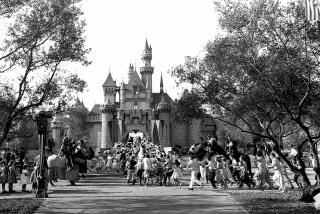My TV Dinner With Mickey : Television: ‘The Mickey Mouse Club’ debuted 35 years ago today. The author, a Mouseketeer, talks about its impact.
When Disneyland opened on July 17, 1955, President Eisenhower was serving his first term, a Cadillac cost less than $3,000 and a new word entered the language: Mouseketeers.
“The Mickey Mouse Club” premiered Oct. 3, 1955, and immediately enthralled millions of children. The ABC hit children’s series ran until 1959, was re-ran from 1961 to 1965, and gave birth to a second version of “The New Mickey Mouse Club” from 1975 to 1977 and from 1983 to 1989 on the Disney Channel. A third spinoff of the show is in its third season.
Nine Mouseketeers lasted from the first day of filming to the last: Annette, Tommy, Karen, Cubby, Doreen, Bobby, Darlene, Sharon, and me--Lonnie. There were three adults--Jimmy Dodd, Roy Williams, and Bob Amsberry--as well as 39 kids during the original show’s four-year life.
The adults have since died, as has Mouseketeer Mike Smith. Sherry Alberoni and Cheryl Holdridge were highly identifiable even though they were on the series for only two years. Two other alumni went on to star in “The Rifleman” (Johnny Crawford) and “My Three Sons” (Don Grady).
Why did a fairly simple kids’ TV show capture the imagination of millions of children and quite a few adults, become a spontaneous hit and last for 35 years in one form or another?
The Mouseketeers and their show appeared at the same time as television was also growing up.
Children had been on TV almost from its inception but they were always child actors playing roles or kids as audience members (the peanut gallery on “Howdy Doody”) or interviewees (Art Linkletter’s “House Party”). The Mouseketeers were, at Walt Disney’s insistence, almost all amateurs as opposed to show business kids. Only Sharon Baird and I had credits as child actor/dancers and managed to sneak by Walt and his producers. So the Mouseketeers were real kids growing up with whom other real kids viewing the show could identify. Walt made it very clear that everyone who watched the show was a member of the club.
Given the schedule of five 15-minute episodes a week plus cartoon introductions and other chores, it is not surprising that some of the Mouseketeers made mistakes--which made us seem very human.
The diversity of the show was a very important factor. The Mouseketeers changed their show every day: Monday was “Fun With Music Day,” Tuesday “Guest Star Day,” Wednesday “Anything Can Happen Day,” Thursday “Circus Day,” and Friday “Talent Roundup.”
The Mouseketeers’ singing and dancing was followed by a children’s serial such as “Spin and Marty” or “The Hardy Boys.” The next segment presented short films on children in other countries, wildlife, growing up on a farm or the American Indians. Millions of kids learned to spell encyclopedia from a cricket. The fourth part of the hour was a Disney cartoon.
Finally, some unassuming kids known as the Mouseketeers became the link between Walt Disney’s characters--Mickey Mouse, Snow White, Donald Duck--and real kids. There was nothing slick or hip about the Mouseketeers. We were real kids who grew up and enjoyed ourselves in front of a nation.
It was quite a trick for Disney to put on those five hours a week in 1955. One could criticize the production values of the show, the repetitive musical numbers and the innocuous dialogue. But kids never seem to care about these criticisms: The “Mickey Mouse Club” was a seminal entertainment that communicated directly to children.
There were faults in the America of the ‘50s, and faults with “The Mickey Mouse Club.” An obvious example would be that although there were two Latinos on the Club, blacks only appeared as guests. This was a reflection of the age and nearly all TV programming at the time. Naturally, the second version of the Mouse Club in the ‘70s and the third show in the ‘80s were both fully integrated.
In their small way, the Mouseketeers and “The Mickey Mouse Club” symbolize for millions a lost American innocence. It is wonderful to be a very tiny part of entertainment history that makes people smile when it is recalled.
More to Read
The complete guide to home viewing
Get Screen Gab for everything about the TV shows and streaming movies everyone’s talking about.
You may occasionally receive promotional content from the Los Angeles Times.






